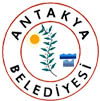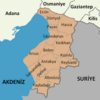Antakya
| Antakya | ||||
|
||||

|
||||
| Basic data | ||||
|---|---|---|---|---|
| Province (il) : | Hatay | |||
| Coordinates : | 36 ° 12 ' N , 36 ° 9' E | |||
| Height : | 67 m | |||
| Residents : | 213,581 (2010) | |||
| Telephone code : | (+90) 326 | |||
| Postal code : | 31 xxx | |||
| License plate : | 31 | |||
| Structure and administration (as of 2019) | ||||
| Mayor : | Izzettin Yılmaz ( AKP ) | |||
| Website: | ||||
| Antakya county | ||||
| Residents : | 461,477 (2010) | |||
| Surface: | 858 km² | |||
| Population density : | 538 inhabitants per km² | |||
Antakya ( Arabic أنطاكية Antakiyyah , former name Antiochia , ancient Greek Αντιόχεια Antiócheia ) is a municipality in the southern Turkish province of Hatay .
history
The Bronze Age city of Alalach (now Tell Açana) was located near Antakya . Alalach was an important regional trading center, its beginnings until about 3400 BC. To be dated. Here the trade routes from Aleppo , Mesopotamia and from Palestine to Anatolia and the Mediterranean crossed. The city was connected to the sea via the Orontes (river) . Trade with Cyprus is documented in writing and archaeologically. Ivory was a source of wealth. The area around Alalach was known for its elephant herds in the Bronze Age.
Today's Antakya lies on the site of the ancient metropolis Antioch on the Orontes.
- → For ancient and medieval history, see Antioch on the Orontes

In 638 Antioch was conquered by the Arabs, in 969 it was reconquered by the Byzantine emperor Nikephorus II. In 1070 Peter Libellisios was imperial governor, from 1074 to 1078 Isaac Komnenus .
After the Byzantine defeat at the Battle of Manzikert (1071), the Armenian adventurer Vasak seized power. Byzantine soldiers killed him in 1076 or 1080, and the former Byzantine general Philaretos Brachamios took control. 1084 the city fell to the Seljuk Sultan Malik Shah I. In June 1098, it was after eight months, privation siege of the Crusaders conquered , in turn, only two days after conquering, stock empty Antioch by the siege by 200,000 soldiers under the leadership of Atabegs Kerbogha from Mosul were threatened. Only after the discovery of the Holy Lance could the approx. 20,000 crusaders (including those who did not fight) put this overwhelming force to flight on June 28, 1098. Byzantium did not support the encircled crusaders, but stopped their own troops at some distance and finally, believing in the imminent defeat of the crusaders, allowed them to return to Byzantium. After the surprising victory of the Crusaders, the city was therefore not returned to Byzantium as agreed, but made the capital of the Principality of Antioch .
During the 12th and 13th centuries Antioch remained in the hands of the Crusaders until it was finally conquered in 1268 by the Mamluks under Sultan Baibars . Baibars destroyed the city so badly that it never regained greater importance. For the looting, Baibars had the city gates bolted and the entire Christian population of tens of thousands of people was killed or enslaved, resulting in a drop in the price of slaves . Antioch became an insignificant small town. The Greek Orthodox Patriarch of Antioch has resided in Damascus since the end of the 14th century . In 1517 the city became part of the Ottoman Empire .
After its division as a result of World War I , Antioch and İskenderun were occupied by the French. In 1923, France received the official League of Nations mandate for both cities and Syria. Ruled by Damascus , Antioch retained status as an autonomous region. Nevertheless, Ataturk's supporters were welcomed with open arms here too . It is said to have been he who gave the area the name Hatay , based on a former Hittite principality.
In 1938 the state of Hatay was proclaimed in Sanjak Alexandrette with Antioch as its capital. This in turn joined Turkey after a referendum in 1939. France held back, hoping to dissuade Turkey from moving closer to Nazi Germany or even re-entering into an alliance. Antakya remained the seat of the governor of Hatay Province. However, it had to cede its status as (economically) the most important city to İskenderun . Since 2014, the entire area of Hatay Province has been organized as the Hatay Metropolitan Municipality ( Hatay Büyükşehir Belediyesi ), within which Antakya is a sub-municipality.
Antakya has been the seat of Mustafa Kemal University since 1992 .
Population and religion
In 2010 about 213,000 people lived in Antakya. The Orontes divides the city into the old and new areas, with the old town uphill. The population consists mainly of Turkish Muslims , there are also Christians , Jews and Alawites . In addition to Turkish , you can also hear the Arabic language .
climate
| Antakya (82 m) | ||||||||||||||||||||||||||||||||||||||||||||||||
|---|---|---|---|---|---|---|---|---|---|---|---|---|---|---|---|---|---|---|---|---|---|---|---|---|---|---|---|---|---|---|---|---|---|---|---|---|---|---|---|---|---|---|---|---|---|---|---|---|
| Climate diagram | ||||||||||||||||||||||||||||||||||||||||||||||||
| ||||||||||||||||||||||||||||||||||||||||||||||||
|
Average Monthly Temperatures and Precipitation for Antakya (82 m)
|
||||||||||||||||||||||||||||||||||||||||||||||||||||||||||||||||||||||||||||||||||||||||||||||||||||||||||||||||||||||||||||||||||||||||||||||||||||||
Sights and surroundings
In Antakya there is an archaeological museum with one of the most important collections of Roman mosaics . Besides the mosques there are several Christian churches . The best known is probably the St. Peter's Grotto , which can be found a bit outside on a mountain slope. It was declared by the Vatican to be the oldest church in Christianity and, according to legend, it was inaugurated by the Apostle Peter .
Southwest of Antakya, the earliest traces of human settlement were discovered: stone tools and worked snail shells that are around 40,000 years old; they have been recovered in the Üçağızlı Cave since the early 1990s .
Surrounded by numerous water sources that supply the drinking water for the city, and huge laurel trees is Harbiye , the recreational area for many Antakyaner, about five kilometers away. The place was a villa town during Roman times and was named after the nymph Daphne , who, according to a legend , wanted to hide here from Apollo and was therefore turned into a laurel tree. Cleopatra is said to have married here once .
About 30 km to the west is the Mediterranean Sea with numerous bays and beaches, near the mouth of the Orontes about six kilometers east of Samandağ is the monastery of Symeon Stylites the Younger on a hill . The crusader castle Cursat is located twelve kilometers to the south near Kozkalesi .
traffic
The city has a domestic airport, Antakya Hatay Airport , which is 20 km from the city center. Internationally, this can be approached directly from Düsseldorf in the summer.
In addition, Antakya has a large bus station, from which all surrounding places such as Iskenderun, Mersin or Adana can be reached by coach. Antakya also has a well-developed city bus network, taxis and the so-called “Dolmuş” minibuses with which the surrounding villages can be reached.
photos
St. Peter's Church (or St. Peter's Grotto )
The Asi Nehri River (or Nahr al-Asi or Orontes )
Twin cities
sons and daughters of the town
For personalities from Antioch on the Orontes see: Antioch on the Orontes # Famous Citizens .
- Walter Sydney Adams (1876–1956), American astronomer
- Selahattin Ülkümen (1914–2003), diplomat
- Vahit Melih Halefoğlu (1919–2017), diplomat and politician
- Halit Çelenk (1922–2011), lawyer and politician
- Ayhan Tumani (* 1971), football coach
- Ahmet Taşyürek (* 1972), football player and coach
- Gökhan Zan (* 1981), football player
- Hüseyin Kala (* 1987), football player
- Kamil İçer (* 1993), football player
- İsmail Çipe (* 1995), soccer goalkeeper
Web links
- City administration website
- Informative pages of the city partnership Aalen-Antakya
- antakya-hatay.info (information and pictures)
- Picture gallery (on askarclub.de)
Individual evidence
- ^ Turkish Institute for Statistics ( Memento from December 21, 2012 in the web archive archive.today ), accessed September 30, 2011
- ^ Turkish Institute for Statistics ( Memento from December 21, 2012 in the web archive archive.today ), accessed September 30, 2011
- ^ Leonard Woolley : A forgotten kingdom: being a record of the results obtained from the excavations of two mounds, Atchana and Al Mina, in the Turkish Hatay. London 1959, p. 17-20, 40-41.
- ↑ Janis Witowski: Antioch 1098: The discovery of the Holy Lance in the eyes of contemporaries . Grin, 2008, p. 4 .
- ^ Edward Gibbon: The History of the Decline and Fall of the Roman Empire . tape 2 . Cincinnati 1844, p. 337 ( google.at ).
- ↑ Thomas S. Asbridge: The Crusades . 7th edition. Klett-Cotta, 2016, p. 94 .
- ↑ Thomas S. Asbridge: The Crusades . 7th edition. Klett-Cotta, 2016, p. 682 .










